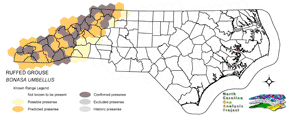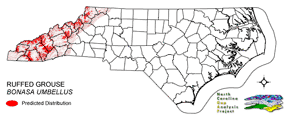
| Taxa: |
| Order: |
| Family: |
| Aves |
| Galliformes |
| Phasianidae |
| NatureServe Global Rank: |
| NatureServe State (NC) Rank: |
| G5 |
| S4 |
| Federal Status: |
| NC State Status: |
| --- |
| --- |


| Land Unit |
| US Fish & Wildlife Service |
| US Forest Service |
| US National Park Service |
| US Department of Defense |
| NC State Parks |
| NC University System |
| NC Wildlife Res. Com. |
| NC Forest Service |
| NC Div. of Coastal Mgmt. |
| Local Governments |
| Non-Governmental Org. |
| Other Public Lands |
| Private Lands |
| GAP Status 1-2 |
| All Protected Lands |
| Statewide |
| Hectares |
| 0.00 |
| 187,061.67 |
| 19.98 |
| 76,306.41 |
| 2,546.37 |
| 65.70 |
| 3,974.94 |
| 660.45 |
| 0.00 |
| 4,973.22 |
| 5,142.24 |
| 7.92 |
| 329,993.91 |
| 107,054.31 |
| 280,580.25 |
| 610,752.81 |
| Acres |
| 0.00 |
| 462,239.36 |
| 49.37 |
| 188,557.21 |
| 6,292.22 |
| 162.35 |
| 9,822.29 |
| 2,331.36 |
| 0.00 |
| 12,289.09 |
| 12,706.75 |
| 19.57 |
| 815,432.55 |
| 265,236.27 |
| 694,028.12 |
| 1,509,902.12 |
| % of Dist. on |
| Prot. Lands |
| 0.0 % |
| 66.7 % |
| 0.0 % |
| 27.2 % |
| 0.9 % |
| < 0.1 % |
| 1.4 % |
| 0.2 % |
| 0.0 % |
| 1.8 % |
| 1.8 % |
| < 0.1 % |
| 0.0 % |
| 38.2 % |
| ----- |
| ----- |
| % of Dist. on |
| All Lands |
| 0.0 % |
| 30.6 % |
| < 0.1 % |
| 12.5 % |
| 0.4 % |
| < 0.1 % |
| 0.7 % |
| 0.1 % |
| 0.0 % |
| 0.8 % |
| 0.8 % |
| < 0.1 % |
| 54.0 % |
| 17.5 % |
| ----- |
| ----- |
|
Found only in the mountains and the extreme western piedmont (Potter et al. 1980). Inhabits the ground and understory (Kaufman 1996) of all wet or dry (AOU 1983) forest types at all elevations (Stupka 1963), but perhaps is less common in pure coniferous forests (Kaufman 1996). Young forests provide optimum conditions (Crawford 1986). Courtship and breeding usually occurs in areas with high density of woody stems (?). Often forages along grassy roadsides (Alsop 1991); also in shrubs or high in trees (Kaufman 1996). Nest is located on the ground at the base of a tree, under a log, rock, or root, or in dense cover (Harrison 1975). Male drums from atop a log, rock, or other elevated perch (Farrand 1983). NATURE SERVE GLOBAL HABITAT COMMENTS: Dense forest with some deciduous trees, in both wet and relatively dry situations from boreal forest (especially early seral stages dominated by aspen) and northern hardwood ecotone to eastern deciduous forest and oak-savanna woodland (AOU 1983). Young forest provides optimum conditions. See Crawford (1986) for additional information on habitat and cover requirements. Nests in forests or woodlands with some deciduous trees. Nest usually at base of tree, bush or stump. Drumming areas and broods usually in areas with high density of woody stems. Broods select habitats with abundant ground cover. In Wisconsin, females nested in areas in which they wintered following natal dispersal (Small and Rusch 1989). |
| Code | Name | Description | NC Natural Heritage Program Equivalent |
| 517 | Hemlock Floodplain Forest | Alluvial forest with hemlock and/or white pine in mountains and western piedmont. Hydrology is generally temporarily to seasonally flooded. | Canada Hemlock Forest |
| 521 | Spruce/Fir Forest | High Elevation Frazer-Fir - Red Spruce, Red Spruce and Red-Spruce-Yellow Birch Forests. Tree densities included here include both woodland to forest density. Highly intermixed with Northern Hardwoods, Grassy Balds, and Shrub Balds. | Red Spruce--Fraser Fir Forest, Fraser Fir Forest |
| 522 | Northern Hardwoods | High Elevation forests including yellow birch, American beech, and yellow buckeye. Includes forests with Hemlock and Yellow Birch. | Northern Hardwoods Forest, Boulderfield Forest |
| 525 | Appalachian Oak Forest | A variety of oak forest types including Black, White, Scarlet Oaks in dry to mesic situations. Includes forests historically co-dominated by American Chestnut. | High Elevation Red Oak Forest, Montane White Oak Forest |
| 526 | Appalachian Cove Forest | Mixed Mesophytic forests of the mountains. Includes tuliptree, basswood, yellow buckeye and surgar maple. This class is mapped to include cove forests dominated or co-dominated by hemlock. | Rich Cove Forest, Acidic Cove Forest |
| 527 | Appalachian Hemlock | Upland hemlock forests of the moutains region. Vary from side slopes to steep slope positions. | Canada Hemlock Forest |
| 529 | Appalachian Xeric Mixed Forest | Mixed forests with Virginia, Shortleaf, Eastern White Pine, Table Mountain and Pitch pines in combination with xeric oak species. Oaks include, white, Southern Red, black, and rock chestnut. | Pine Oak Heath |
| 530 | Appalachian Xeric Deciduous Forest | Deciduous forests in the mountains dominated by Xeric Oak species. Species include, white, Southern red, black, and rock chestnut. | High Elevation Red Oak Forest, Montane White Oak Forest |
|
Ellsworth, D. L., R. L. Honeycut, and N. J. Silvy. 1995. Phylogenetic relationships among North American grouse inferred from restriction endonuclease analysis of mitochondrial DNA. Condor 97:492-502.
Bump, G. et. al. 1947. The ruffed grouse:life history, propagation and management. New York State Conservation Department. 1947. 915 pp. Edminster, F.C. 1947. The ruffled grouse -- its life story, ecology, and management. Macmillan, New York. 385 pp. Kaufman K. 1996. Lives of North American Birds. Boston, New York: Houghton Mifflin Company. Williamson, S. J. No date. Forester's guide to wildlife habitat improvement. Cooperative Extension Service, Univ. of New Hampshire. 56 pp. Small, R. J., and D. H. Rusch. 1989. The natal dispersal of ruffed grouse. Auk 106:72-79. Thompson, F.R., III and E.K. Fritzell. 1989. Habitat use, home range, and survival of territorial male ruffed grouse. J. of Wildlife Management 53:15-21. Godfrey, W.E. 1966. The birds of Canada. National Museums of Canada. Ottawa. 428 pp. Johnsgard, P. A. 1973. Grouse and quail of North America. U. of Nebraska, Lincoln. 553 pp. Harrison, C. 1978. A field guide to the nests, eggs and nestlings of North American birds. Collins, Cleveland, Ohio. Potter, E. F., J. F. Parnell, and R. P. Teulings. 1980. Birds of the Carolinas. Univ. North Carolina Press, Chapel Hill. 408 pp. Terres, J.K. 1980. The Audubon Society encyclopedia of North American birds. Alfred A. Knopf, New York. American Ornithologists' Union (AOU), Committee on Classification and Nomenclature. 1983. Check-list of North American Birds. Sixth Edition. American Ornithologists' Union, Allen Press, Inc., Lawrence, Kansas. Farrand, J., editor. 1983. Audubon Society master guide to birding. Alfred A. Knopf, New York. 3 vols., 1244 pp. Johnsgard, P. A. 1983. The grouse of the world. Univ. Nebraska Press, Lincoln. xvi + 413 pp. Crawford, J. A. 1986. Ruffed grouse (BONASA UMBELLUS). Section 4.1.1, US Army Corps of Engineers Wildlife Resources Management Manual. Tech. Rep. EL-86-4. US Army Corps of Engineers Waterways Expt. Sta., Vicksburg, Mississippi. 42 pp. Bergerud, A. T., and M. W. Gratson, editors. 1987. Adaptive strategies and population ecology of northern grouse. Univ. Minnesoat Press. 785 pp. Atwater, S., and J. Schnell, eds. 1989. Ruffed grouse. Stackpole Wildlife Series. xiii + 370 pp. Servello, F. A., and R. L. Kirkpatrick. 1987. Regional variation in the nutritional ecology of ruffed grouse. J. Wildl. Manage. 51:749-770. Gullion, G. 1989. The ruffed grouse. NorthWord. 144 pp. Wakeley, J. S., T. H. Roberts, and C. O. Martin. 1990. Auditory survey methods. Section 6.3.5, US Army Corps of Engineers Wildlife Resources Management Manual. Tech. Rep. EL-90-7. Waterways Expt. Station, Vicksburg, Mississippi. 34 pp. Alsop FJ III. 1991. Birds of the Smokies. Gatlinburg: Great Smoky Mountains Natural History Association. Rusch, D. H., and L. B. Keith. 1971. Seasonal and annual trends in numbers of Alberta ruffed grouse. J. Wildl. Manage. 35:803-822. |
For more information please contact them at:
NC-GAP Analysis Project
Dept. of Zoology, NCSU
Campus Box 7617
Raleigh, NC 27695-7617
(919) 513-2853
www.basic.ncsu.edu/ncgap